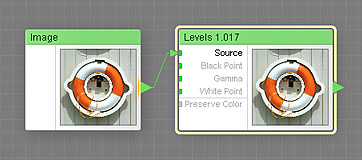
This component is obsolete and its use in filters is not recommended. Use the recent version of the component.
The Levels component adjusts the tonal range of the image provided by the Source input. The Black Point and the White Point parameters define the clipping thresholds, and the R, G, and B values between these thresholds are redistributed between levels 0 and 100. This redistribution increases the tonal range of the image, in effect increasing its contrast. Levels affects only the color of the source image, it does not affect its alpha channel. This is a map component, it can be located in the Adjustments category on the Components Bar.
Provides the source image on which the adjustment will be performed. This is a required input – in order to make the Levels component work, this input must be connected.
Black Point: Map Input
Specifies the bottom clipping level for R, G and B channels of the source image. The clipping is performed channelwise. For example, Black Point of 20 means that all R, G and B values in the source image that are equal or below 20% will be reset to zero, and values that are greater than 20% will be rescaled to the new tonal range. The Black Point value should be lower than the White Point value (when the Black Point value is greater than the White Point value, they get reversed – the Black Point parameter defines the White Point value and vice versa). Since Black Point is a map input, its value can be controlled separately for different image areas by connecting a map component to this input.
Gamma: Map Input
Specifies the amount of gamma correction to be applied to the source image after the tonal range adjustment. Gamma correction affects mostly the midtones of the source image, it has less effect on the highlight and shadow areas. Values above 0 result in brighter midtones, and values below 0 lead to darker midtones. Completely black and completely white areas remain unaffected. Gamma value of 0 has no effect on the resulting image.
Filter Forge uses values ranging from -100 to 100 to specify the gamma value. The value of 0 is equivalent to gamma of 1 and has no effect on the source image – see Gamma Correction for the table of gamma values and their corresponding Filter Forge percentages. Since Gamma is a map input, its value can be controlled separately for different image areas by connecting a map component to this input.
White Point: Map Input
Specifies the higher clipping level for R, G and B channels of the source image. The clipping is performed channelwise. For example, White Point of 80 means that all R, G and B values in the source image that are higher than 80% will be set to the maximum, and values that are equal or lower than 80% will be rescaled to the new tonal range. The White Point value should be higher than the Black Point value (when the White Point value is lower than the Black Point value, they get reversed – the White Point parameter defines the Black Point value and vice versa). Since White Point is a map input, its value can be controlled separately for different image areas by connecting a map component to this input.
When turned on, the adjustment affects only the lightness of the source image, leaving its hue and saturation unchanged. For more information, see Preserve Color: How It Works.